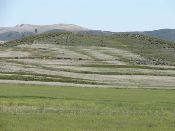|
A combination of models (PESERA and DESMICE) were used by DESIRE to identify the likely environmental effects of proposed remediation strategies and what strategies should be implemented where to achieve cost-effective desertification mitigation.
The process is described in the articles below and the results are presented for each study site.
 |
»PESERA-DESMICE model: calibration and scenario analysis
The PESERA and DESMICE models were used in combination to identify suitable areas in the study sites for implementing various remediation options, the likely biophysical consequences and the costs and economic benefits of doing so. This article explains how this was done.
|
 |
»Guide to PESERA-DESMICE output
The model results for each study site are presented in a generic format which is explained in this article. The discussion includes: study site details; overview of scenarios; baseline, technology, policy, adoption and global scenarios in detail; concluding remarks including the general context for environmental change and the feasibility of remediation options.
|
 |
»Synthesis of scenario results for all study sites
The effectiveness and financial viability of a range of agronomic, management, structural and vegetative measures is compared for all the study sites. (Simple) technological options exist that can minimize land degradation and increase food production. Many technologies are however only profitable in the long run (e.g 20 years) which means that high investment costs are a bottleneck for adoption.
|
 |
»Scale issues and uncertainty analysis
»Data quality, findings, novelties and shortcomings
The PESERA-DESMICE modelling approach overcomes a number of challenges to incorporate inputs from multiple stakeholders in very different contexts into the modelling process, in order to enhance both the realism and relevance of outputs for policy and practice.
|
More details ... baseline conditions, scenarios and model application results for each study site
|
|
»Guadalentín, Spain
»Mação, Portugal
»Góis, Portugal
»Rendina, Italy
»Crete, Greece
»Nestos River Delta, Greece
»Karapinar, Turkey
»Eskisehir, Turkey
»Sehoul, Morocco
|
»Zeuss Koutine, Tunisia
»Dzhanibek, Russia
»Novy, Russia
»Yan River Delta, China
»Boteti, Botswana
»Cointzio, Mexico
»Secano Interior, Chile
»Ribeira Seca, Cape Verde |
A more detailed study of the Guadalentín study site exemplifies how modelling tools can be employed to study the dynamics and consequences of land use change under drivers of desertification, here with particular reference to unsustainable water use. The modelling makes use of land use change analysis, agent-based modelling and input-output analysis.
|
|
|







